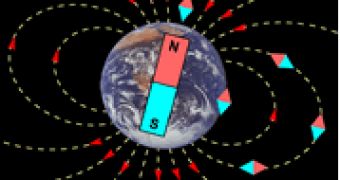Earth's magnetic field is known to influence the behavior of living creatures, from bacteria to plants and animals. Fish (including sharks), whales, dolphins, bats, sea turtles and birds, many animal species are known to detect the magnetic field of the planet. A new research published in the Science journal has, for the first time, found the chemical that could enable birds to "see" the lines of the Earth's magnetic field, thus settling a debate of almost 40 years.
In 2004, tiny deposits of a mineral called magnetite (lodestone) were discovered in the beaks of pigeons and bobolink (a North American songbird). If a small magnet impairs their reception of the Earth's magnetism or a certain area has a natural disturbance of the terrestrial magnetism, pigeons get disoriented and cannot find the way back on long distances.
European robins and other 20 songbirds and pigeons were proven to rely on Earth's magnetic field to navigate during their seasonal migrations. In fact, migratory birds are believed to use magnetism rather than sight to carry through their long journeys. Birds and many non-mammal magnetic sensitive animals are known to perceive and use the Earth's magnetic field inclination in order to assess relative latitude. This angle is 90 degrees at the poles (perpendicular to the Earth) and 0 degrees in the equatorial area (parallel to the Earth). There are bird species, like the Arctic Tern, that use this information to make annual journeys from the North to the South Pole and back.
Researchers had attributed magnetism detection to light exposure, magnetite receptors, or both, believing that birds use a light-connected mechanism in the eye for directional information, and a magnetite receptor in the upper beak to perceive the changes in magnetic intensity. It was known that chickens detect terrestrial magnetism using their eyes, as an experiment showed that the birds could orient themselves under blue light, but totally lost the sense of direction under longer-wavelength lighting. The order of the chickens (Galliformes) and that of the robins (Passeriformes) split from a common group more than 66 Ma ago, and as both types have a similar magnetic compass, this means birds developed this ability early in their evolution, long before the migration behavior emerged.
The cryptochromes
Now, the team at the University of Oxford has found a chemical sensitive to the weak geomagnetic field of the Earth in the bird eye. Cryptochromes are light-sensitive proteins encountered in bacteria, plants and animals, crucial in controlling the circadian rhythm (and with it anything from plant growth to mass spawning of the corals). Several years ago, Henrik Mouritsen of the University of Oldenburg in Germany found them in the retinal neurons of migratory garden warblers, cells that are active at dusk, when these birds use magnetic orientation.
Cryptochromes are hard to get (thus, to investigate), but the new research revealed that a carotenoid-porphyrin-fullerene triad, chemically similar to cryptochromes, is sensitive to weak magnetism. The CPF molecule is activated by specific wavelength light, to deliver two free radicals. The team showed that the concentrations of each free radical in the CPF solution was modified by a magnetic field.
"Most chemists would have predicted that the extremely weak magnetic field could not possibly have an effect on molecules because the electromagnetism would be completely swamped by the molecules' inherent energy. They are just tiny, tiny perturbations," said co-author Peter Hore.
Migratory birds seem to be able to orientate at dusk, and cryptochromes form free radicals under the action of blue light, which happens to be specific to the dusk.
"Dusk might activate the birds' magnetic sense, producing the radical pair. The concentrations of each free radical would be controlled by the Earth's magnetic field, which is known to vary with latitude. As a result, the radicals would bind in varying degrees with other signaling molecules, depending on how far north or south the animal is," said Hore.
Older theories say that birds would have an additional layer in their retina for "seeing" the magnetic field. "Having that on all the time would be distracting, so you can see why it would be desirable for the system to switch on and off," said Hore.
The quantum zeno effect
Another new research points to the existence of a quantum effect enabling the birds to see the magnetic field via photosensitive proteins in their retinas. When a photon strikes one of these proteins, it forms a pair of oppositely charged ions, free for a moment before recombining.
Each ion has electrons with a quantum property called spin. The spins are in opposite directions - but a magnetic field tends to align them. This alignment causes a biochemical reaction that can be recorded by the retina. The problem is that the ions recombine about 10 times faster than the rhythm at which the Earth's magnetic field could influence the spins of the electrons. Now, Iannis Kominis at the University of Crete, explains this by means of the quantum zeno effect: the act of observing a quantum system can affect its evolution, maintaining its state for longer than expected. This way, the turning of the molecules from ortho to para isomers could be slowed down when constantly colliding.
"A similar thing happens in birds: the presence of a geomagnetic field extends the lifetime of the singlet-triplet mixture from which the ions recombine. This gives the magnetic field time to bias the outcome of the recombination," said Kominis.
This theory would explain the odd observations about avian magnetoreception, like the heading error of about 30 degrees common in birds, and why bird compasses seems to react only to a certain window of magnetic field strength.
"The window depends on the hyperfine couplings of the atoms involved which have been selected for by evolution. We may well see similar effects elsewhere. A similar mechanism might be at work in photosynthesis," said Kominis.

 14 DAY TRIAL //
14 DAY TRIAL //